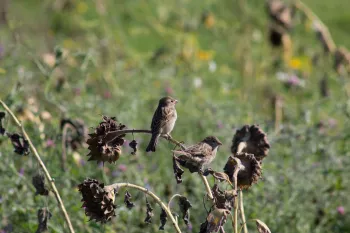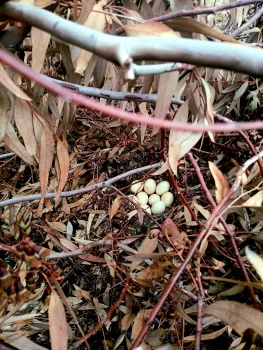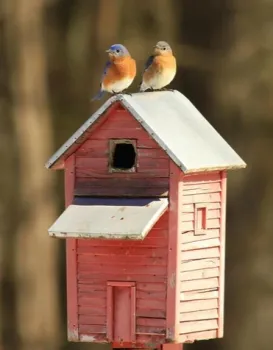
Article by Diana Herrera -
Winter months can be a challenging time for wildlife as their food sources become scarcer, and they seek shelter from the elements. There are lots of things we can do – or not do - in our gardens to support our local wildlife which play important ecological roles in the environment, contribute to our biodiversity, and bring so much beauty to our landscapes.
Sometimes less effort on your end could mean greater benefits to wildlife. First let’s consider some of the things we can simply leave alone in the garden to provide food and shelter for animals.
Leave Behind Dead Plants
Gardeners might start clearing out the summer and fall plants in the garden to make way for the winter vegetables but before getting too carried away, consider what plant material can be kept in order to provide some food or shelter for wildlife. Asters, goldenrods, coneflowers, milkweed, and sunflowers keep their seedheads in the winter and can provide food for our native granivores like finches, sparrows, and towhees. The seeds that are left behind will sow new plants for the following year.

Put the Rake Away
Many of us may be tempted to clean up all of the fallen leaves that our trees shed in autumn but leaving them alone creates a good habitat for wildlife. Invertebrates, birds, amphibians, and mammals all use leaf litter for nesting material, food, or shelter. Some butterfly and moth caterpillars also undergo a sort of hibernation called diapause during which they hide out under fallen leaves until they are ready to emerge in spring. Another good reason for gardeners to leave the leaves is that they act like a natural mulch which suppresses weeds and adds nutrients back into the soil as they break down.
Keep Your Pruning Cut-offs
Gardeners with trees and shrubs in their yards may be doing some pruning around this time of the year, as many of these plants go into winter dormancy. Keeping your cuttings in a brush pile makes an excellent habitat for wildlife. It creates a shelter for small mammals such as squirrels and voles, reptiles, and amphibians. Many birds also use these spaces for shelter and nesting sites, and some hawks even use them as hunting grounds. As the wood from these piles decays, it attracts insects that small mammals and birds can eat. Eventually, it will cycle nutrients back to your soil as well.
There are also some hands-on approaches for attracting wildlife to our gardens and things that we can do to prepare the garden as we head into winter.
Plant Winter Flowering Species

Planting native species that flower throughout the year or in winter helps support local bats, birds, butterflies, caterpillars, bees, and moths that have co-evolved alongside those plants. Some evergreen shrubs that flower in winter and also produce berries are Common Manzanita (Arctostaphylos manzanita) and Hollyleaf Redberry (Rhamnus ilicifolia). As shrubs, they also have the added benefit of providing shelter for animals. Some perennial herbs that will add lovely colors to your garden and welcome bees and butterflies are California Buttercup (Ranunculus californicus), Blue Dicks (Dipterostemon capitatus), and the Bee Plant (Scrophularia californica). The Bee Plant is not only a food source for bees, wasps, and hummingbirds, but it is also a host plant for Common Buckeye and Chalcedon Checkerspot butterflies. Lastly, this late fall season is the perfect time to sow seeds for our state flower – the California Poppy (Eschscholzia californica) can begin blooming in February and is enjoyed by a variety of pollinators.
Whatever you decide to plant, think about incorporating a mix of deciduous, evergreens, shrubs, trees, annuals, and perennials. Creating a diverse habitat with vertical layering helps support a variety of animals with different needs and at different stages of development.
Provide Birdhouses or Bat Boxes
Installing a birdhouse in your garden is an excellent way to provide shelter and a safe place to nest for birds. When setting up a birdhouse, consider the height at which it will be mounted, the size of the entrance hole, and the interior dimensions for the types of birds you would like to attract. Think about the kinds of birds you usually see in your neighborhood to get an idea of who might be moving in. It is recommended that birdhouses be cleaned regularly to prevent diseases from spreading, so it is a good idea to choose one that is easily accessible.

Bats are also very important in our gardens and farms as they pollinate, disperse seeds, and control insect populations. The Sacramento Valley is home to the big brown bat and the Mexican free-tailed bat, both of which consume enormous amounts of agricultural pests and mosquitoes, so we have a lot to thank them for. If you’d like to install a bat box, mount it at least twelve feet high on a tree or solid structure facing south so that it can take advantage of the warm sunshine.
Offer Some Food or Water
Many birds can supplement their diets with birdseed, suet, fruit, and nectar from feeders, especially in winter when their natural foods are scarce. Locating feeders at different heights makes it easier to attract a more diverse crowd. Towhees, sparrows, and juncos feed on the ground; finches feed in shrubs; woodpeckers, nuthatches, and titmice feed in trees. Providing different seeds also attracts more species to your feeders. If you are using a seed mix, it is good to find one that contains cracked corn, millet, and sunflower seeds, as these will readily be eaten by sunflower specialists (birds that are drawn to high-fat, easy-to-crack seeds) and ground feeders. Dried fruit, nuts, and peanuts are good for attracting titmice, woodpeckers, and nuthatches. Dried fruits on table feeders can attract bluebirds, waxwings, robins, and mockingbirds.
Placing a birdbath or water bowl in the garden can also attract many kinds of wildlife to your space, not only birds. Water bowls set on the ground are good for mammals and insects, too. Wide shallow dishes with stones or branches at the bottom allow small animals to access the water safely, and birds can also drink without submerging, which is important in the winter when they need to conserve body heat.
Our native plants and animals help keep our ecosystem in balance, and they bring vibrancy and life to our landscapes. Creating a habitat garden can be as simple as not picking up your fallen leaves, or it can be a little bit more involved. It can be an opportunity to get creative by building your own bat box or trying a homemade recipe for your bird feeder. We can all contribute to conservation even through small efforts in our own backyards.
